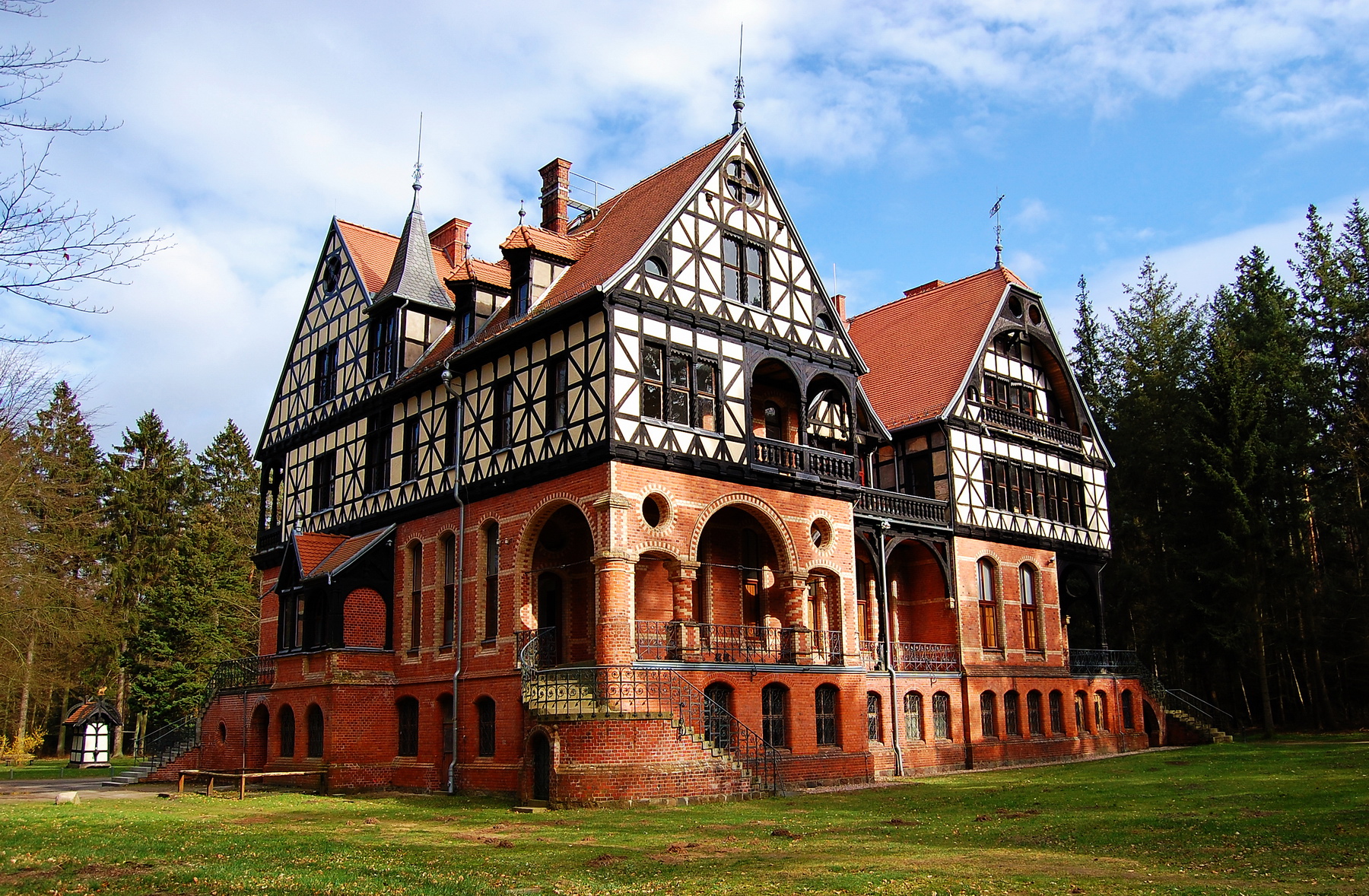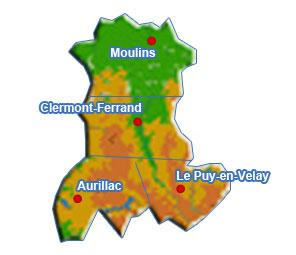|
Castle Marguerite
The Villa Marguerite or Château Marguerite is a mansion in Neussargues-Moissac in the Cantal department in the Auvergne region of France. History The Villa Marguerite is a late 19th-century French mansion, the present form of which is due to its second owner, Maurice Guibal, a former mayor of Murat, Cantal Murat () is a commune in the Cantal department in the Auvergne region in south-central France. On 1 January 2017, the former commune of Chastel-sur-Murat was merged into Murat. Murat is the administrative seat of this new commune. History ..., who named it after his daughter. Villa Marguerite is a distinctive landmark of Neussargues-Moissac and often features on post cards of the town. Notes and references [...More Info...] [...Related Items...] OR: [Wikipedia] [Google] [Baidu] |
Mansion
A mansion is a large dwelling house. The word itself derives through Old French from the Latin word ''mansio'' "dwelling", an abstract noun derived from the verb ''manere'' "to dwell". The English word '' manse'' originally defined a property large enough for the parish priest to maintain himself, but a mansion is no longer self-sustaining in this way (compare a Roman or medieval villa). ''Manor'' comes from the same root—territorial holdings granted to a lord who would "remain" there. Following the fall of Rome, the practice of building unfortified villas ceased. Today, the oldest inhabited mansions around the world usually began their existence as fortified houses in the Middle Ages. As social conditions slowly changed and stabilised fortifications were able to be reduced, and over the centuries gave way to comfort. It became fashionable and possible for homes to be beautiful rather than grim and forbidding allowing for the development of the modern mansion. In British Engl ... [...More Info...] [...Related Items...] OR: [Wikipedia] [Google] [Baidu] |
Neussargues-Moissac
Neussargues-Moissac (Auvergnat: ''Nuçargues e Moissac'') is a former commune in the Cantal department in south-central France. On 1 December 2016, it was merged into the new commune Neussargues en Pinatelle. Population Sights * Château St Benoît: owned by the family of Olivier Messiaen's first wife, Claire Delbos. Messiaen worked on '' L'Ascension'' there. * Castle Marguerite (Villa ou Château Marguerite): 19th century building. *The Valley of Alagnon * Villa Marguerite: late 19th-century French mansion. The river Alagnon is tributary of the Allier. Personalities * Olivier Messiaen OM 022b - L'Ascension, pour orgue eussargues, été 1933 puis Paris, 1934 * Claire Delbos, violinist, first wife of the composer Olivier Messiaen. See also *Communes of the Cantal department The following is a list of the 246 Communes of France, communes of the Cantal Departments of France, department of France. Intercommunalities The communes cooperate in the following Communes of ... [...More Info...] [...Related Items...] OR: [Wikipedia] [Google] [Baidu] |
Cantal
Cantal (; oc, Cantal or ) is a department in the Auvergne-Rhône-Alpes region of France, with its prefecture in Aurillac. Its other principal towns are Saint-Flour (the episcopal see) and Mauriac; its residents are known as Cantalians (french: link=no, Cantaliens / Cantaliennes or '). Cantal borders the departments of Puy-de-Dôme, Haute-Loire, Aveyron, Lot, Lozère and Corrèze, in the Massif Central natural region. Along with neighbouring Lozère and Creuse, Cantal is among the most sparsely populated and geographically isolated departments of France and Aurillac is the departmental capital farthest removed from a major motorway. It had a population of 144,692 in 2019,Populations légales 2019: 15 Cantal INSEE making it the country's 98th most populated department. Of the 96 me ... [...More Info...] [...Related Items...] OR: [Wikipedia] [Google] [Baidu] |
Departments Of France
In the administrative divisions of France, the department (french: département, ) is one of the three levels of government under the national level ("territorial collectivities"), between the administrative regions and the communes. Ninety-six departments are in metropolitan France, and five are overseas departments, which are also classified as overseas regions. Departments are further subdivided into 332 arrondissements, and these are divided into cantons. The last two levels of government have no autonomy; they are the basis of local organisation of police, fire departments and, sometimes, administration of elections. Each department is administered by an elected body called a departmental council ( ing. lur.. From 1800 to April 2015, these were called general councils ( ing. lur.. Each council has a president. Their main areas of responsibility include the management of a number of social and welfare allowances, of junior high school () buildings and technical ... [...More Info...] [...Related Items...] OR: [Wikipedia] [Google] [Baidu] |
Auvergne (region)
Auvergne (; ; oc, label= Occitan, Auvèrnhe or ) is a former administrative region in central France, comprising the four departments of Allier, Puy-de-Dôme, Cantal and Haute-Loire. Since 1 January 2016, it has been part of the new region Auvergne-Rhône-Alpes.. The administrative region of Auvergne is larger than the historical province of Auvergne, one of the seven counties of Occitania, and includes provinces and areas that historically were not part of Auvergne. The Auvergne region is composed of the following old provinces: * Auvergne: departments of Puy-de-Dôme, Cantal, northwest of Haute-Loire, and extreme south of Allier. The province of Auvergne is entirely contained inside the Auvergne region * Bourbonnais: department of Allier. A small part of Bourbonnais lies outside Auvergne, in the neighbouring Centre-Val de Loire region (south of the department of Cher). * Velay: centre and southeast of department of Haute-Loire. Velay is entirely contained inside the Auvergne ... [...More Info...] [...Related Items...] OR: [Wikipedia] [Google] [Baidu] |
Regions Of France
France is divided into eighteen administrative regions (french: régions, singular ), of which thirteen are located in metropolitan France (in Europe), while the other five are overseas regions (not to be confused with the overseas collectivities, which have a semi-autonomous status). All of the thirteen metropolitan administrative regions (including Corsica ) are further subdivided into two to thirteen administrative departments, with the prefect of each region's administrative centre's department also acting as the regional prefect. The overseas regions administratively consist of only one department each and hence also have the status of overseas departments. Most administrative regions also have the status of regional territorial collectivities, which comes with a local government, with departmental and communal collectivities below the region level. The exceptions are Corsica, French Guiana, Mayotte and Martinique, where region and department functions are managed ... [...More Info...] [...Related Items...] OR: [Wikipedia] [Google] [Baidu] |
France
France (), officially the French Republic ( ), is a country primarily located in Western Europe. It also comprises of overseas regions and territories in the Americas and the Atlantic, Pacific and Indian Oceans. Its metropolitan area extends from the Rhine to the Atlantic Ocean and from the Mediterranean Sea to the English Channel and the North Sea; overseas territories include French Guiana in South America, Saint Pierre and Miquelon in the North Atlantic, the French West Indies, and many islands in Oceania and the Indian Ocean. Due to its several coastal territories, France has the largest exclusive economic zone in the world. France borders Belgium, Luxembourg, Germany, Switzerland, Monaco, Italy, Andorra, and Spain in continental Europe, as well as the Netherlands, Suriname, and Brazil in the Americas via its overseas territories in French Guiana and Saint Martin. Its eighteen integral regions (five of which are overseas) span a combined area of ... [...More Info...] [...Related Items...] OR: [Wikipedia] [Google] [Baidu] |
Murat, Cantal
Murat () is a commune in the Cantal department in the Auvergne region in south-central France. On 1 January 2017, the former commune of Chastel-sur-Murat was merged into Murat. Murat is the administrative seat of this new commune. History On 24 June 1944, during World War II, 120 Muratais were deported, 80 never returned. The French people from Murat were deported via Compiègne to the Neuengamme concentration camp and most of them had to work in the subcamp (in German: Außenlager) Farge concentration camp. At begin of June, 2012 a monument in the Memorial wood on the gardening area of former concentration camp was established: It was donated by the city of Murat, to remember what happened in Murat and to commemorate the deported and murdered inhabitants. The columns of basalt remember July 1944 when the Maquisards from Murat, Cantal were deported and afterwards murdered in the Neuengamme concentration camp and its affiliates. In total 75 men out of 103 died in the c ... [...More Info...] [...Related Items...] OR: [Wikipedia] [Google] [Baidu] |
Buildings And Structures In Cantal
A building, or edifice, is an enclosed structure with a roof and walls standing more or less permanently in one place, such as a house or factory (although there's also portable buildings). Buildings come in a variety of sizes, shapes, and functions, and have been adapted throughout history for a wide number of factors, from building materials available, to weather conditions, land prices, ground conditions, specific uses, prestige, and aesthetic reasons. To better understand the term ''building'' compare the list of nonbuilding structures. Buildings serve several societal needs – primarily as shelter from weather, security, living space, privacy, to store belongings, and to comfortably live and work. A building as a shelter represents a physical division of the human habitat (a place of comfort and safety) and the ''outside'' (a place that at times may be harsh and harmful). Ever since the first cave paintings, buildings have also become objects or canvasses of much art ... [...More Info...] [...Related Items...] OR: [Wikipedia] [Google] [Baidu] |
Houses Completed In The 19th Century
A house is a single-unit residential building. It may range in complexity from a rudimentary hut to a complex structure of wood, masonry, concrete or other material, outfitted with plumbing, electrical, and heating, ventilation, and air conditioning systems.Schoenauer, Norbert (2000). ''6,000 Years of Housing'' (rev. ed.) (New York: W.W. Norton & Company). Houses use a range of different roofing systems to keep precipitation such as rain from getting into the dwelling space. Houses may have doors or locks to secure the dwelling space and protect its inhabitants and contents from burglars or other trespassers. Most conventional modern houses in Western cultures will contain one or more bedrooms and bathrooms, a kitchen or cooking area, and a living room. A house may have a separate dining room, or the eating area may be integrated into another room. Some large houses in North America have a recreation room. In traditional agriculture-oriented societies, domestic animals such ... [...More Info...] [...Related Items...] OR: [Wikipedia] [Google] [Baidu] |
Villas In France
Villas may refer to: Places * Villas, Florida, United States * Villas, Illinois, United States * Villas, New Jersey, United States * Las Villas, a region of Spain * Las Villas (Cuba), a former Cuban Province * The Villas, a housing estate in Stoke-upon-Trent, England Other uses * Villa, a type of house * ''Villa'' (fly), a genus of insects * The Villas (band), an American rock band * Violetta Villas (1938–2011), Belgian-born Polish singer, actress, and songwriter See also *Las Tres Villas *Cinco Villas (other) *Castillo Siete Villas, a town in Arnuero, Cantabria, Spain *Villasbuenas *Villas Boas *Benalúa de las Villas *Villa (other) A villa is a house. Villa may also refer to: Places *Villa, Rõuge Parish, a village in Rõuge Parish, Võru County, Estonia * Villa, Võru Parish, a village in Võru Parish, Võru County, Estonia *Villa, Viljandi County, a village in Viljand ... * Vila (other) * Vilas (other) {{disambiguation, ... [...More Info...] [...Related Items...] OR: [Wikipedia] [Google] [Baidu] |




